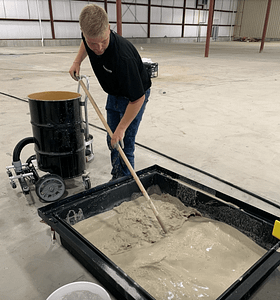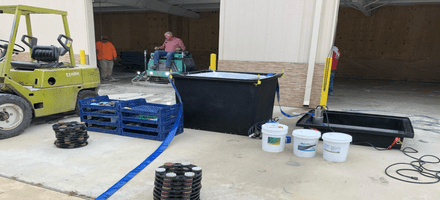Slurry is a hazardous liquid that often results from wet polishing concrete surfaces with abrasive tools. While it’s more than a simple nuisance—sometimes utilized for floor repair, like filling air bubbles in concrete surfaces—slurry is still a danger to the surrounding environment if not properly disposed of.
In the last four years, since OSHA implemented a new silica exposure standard in 2017, there’s been a rise in mechanical wet polishing for concrete surface prep. Wet polishing provides an opportunity to stop silica dust in its tracks as it is trapped by the water rather than suspended in the air (and therefore a breathing hazard for workers).
Of course, convenient as wet polishing may be, the process isn’t perfect. Where one hazard is prevented, another takes its place. Consequently, workers will need to understand adequate slurry management to combat the environmental hazards posed by the liquid. We’ve lain out the basics of slurry management in this post, as well as the equipment and products necessary to maintain a clean environment.
Ways to Manage and Dispose of Slurry
You cannot legally dispose of slurry in a dumpster or sewer, making it especially difficult to deal with large amounts of slurry that result from covering extensive surface areas with a floor grinder or power trowel.
Instead, you must first work to separate slurry back into its two primary components: water and cement. To do this, you’ll need slurry solutions like SlurrySep which help you to separate the solids and liquids, resulting in a sludge that may be disposed of as a solid, construction waste material.
How Does It Work?
Solutions like SlurrySep Treatment are bentonite clay-based flocculant that are designed for high pH water. Despite a somewhat short  process, there’s a lot going on once this solution enters the slurry mix. The acidic component first causes oily contaminants to coalesce and separate from the wastewater. Then, the polarimetric catatonic portion of the formulation attracts any remaining oils and larger, more highly charged anions.
process, there’s a lot going on once this solution enters the slurry mix. The acidic component first causes oily contaminants to coalesce and separate from the wastewater. Then, the polarimetric catatonic portion of the formulation attracts any remaining oils and larger, more highly charged anions.
Hang on, because this is when the science really gets rolling. The basic component then activates, precipitating metallic hydroxides and driving the system to a fully flocculated condition where the catatonic polymer molecules metallic ions and positively charged contaminants are attracted to the SlurrySep clay particles.
Consequently, the separated elements will not be remixed as the treatment process is permanently isolated from the contaminants in what’s called a “non-leachable” form.
What You’ll Need
While your accessories will vary depending on your polishing method and other factors, typical material and equipment you’ll need for the process include:
- Adequate hoses
- Wet vacuum cleaner
- Clean water sump pump
- Extension cord
- Mixing tote or dumpster
- Slurry bag tote
- Dewatering slurry bags
- SlurrySep flocculant
- Slurry Destroyer
At first glance, it may seem like there are a lot of moving parts. With the right solution, the labor on your part is actually quite minimal. You’re simply mixing in the right amount of slurry management treatment into your collected slurry, allowing for the liquid to separate, and disposing accordingly. That said, even if you’ve done this before, we recommend following the instructions laid out on your solution’s label.
Why Professionals Use the Wet Polishing Method
You may find yourself wondering: why even wet polish a floor? Doesn’t dry polishing get the job done just as well? Well, there are several reasons that go beyond the prevention of silica accumulation as mentioned previously.
First and foremost, wet polishing is the oldest form of polishing and it was only by accident that dry polishing as a viable method was discovered. When water is brought into the process, a lot of important things happen.
Most significant: the use of water in mechanical wet polishing acts as a lubricant, helping reduce friction as the water cools the diamond tooling.This may help to maintain your equipment as it also simultaneously cleans the abrasives. Furthermore, when wet polishing, you also stand much less of a chance of overheating and melting the floor resin.
Concrete Flooring Prep Rental and Sales Facility
At Runyon Surface Prep, we pride ourselves in being more than just a distributor of quality products. We believe that building a good relationship with our customers and partners will result in a win for everyone involved. We also offer technical training in trowel polishing, concrete polishing, surface preparation, and much more. Give us a call or reach out online to learn more about how we can help.
